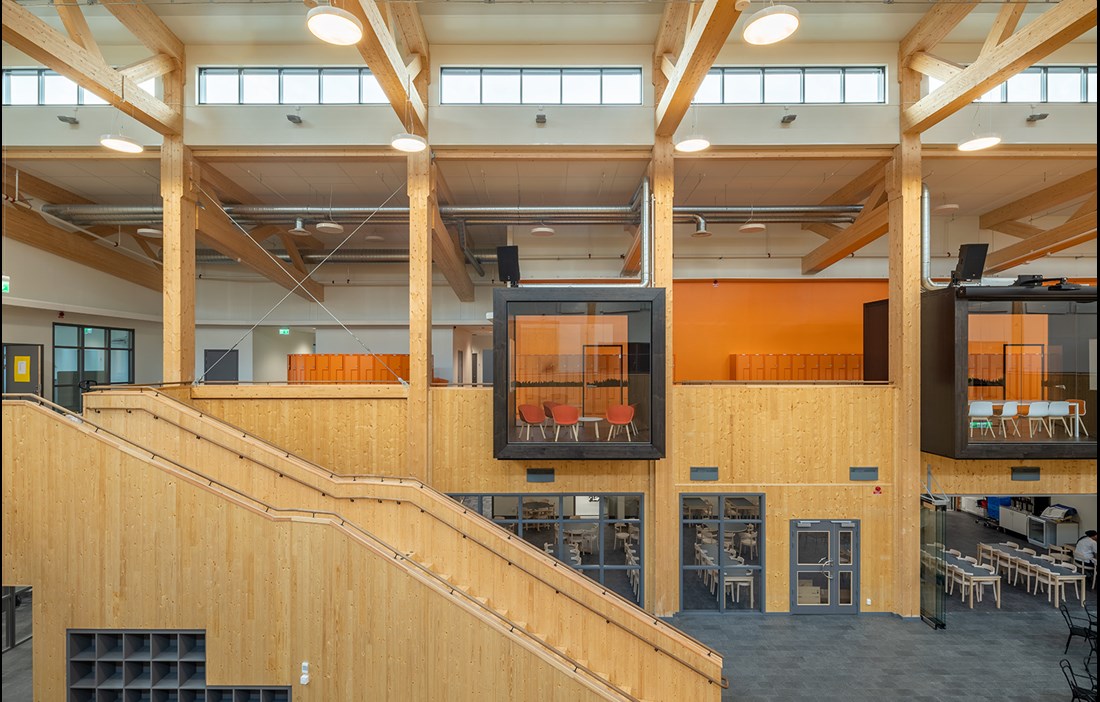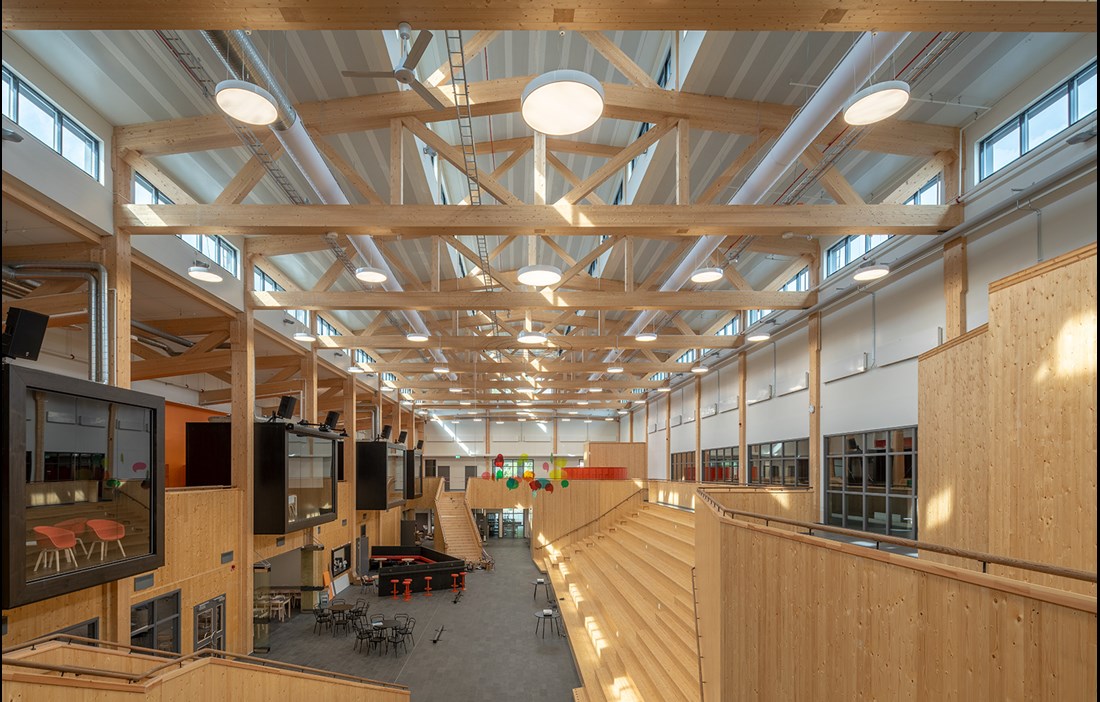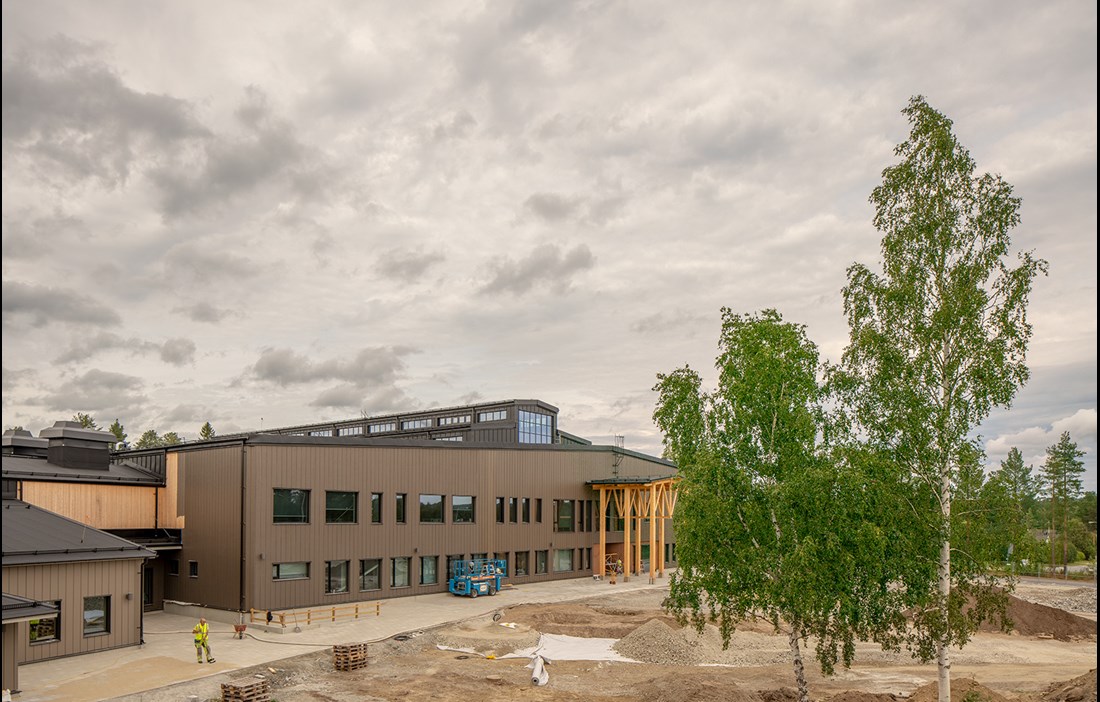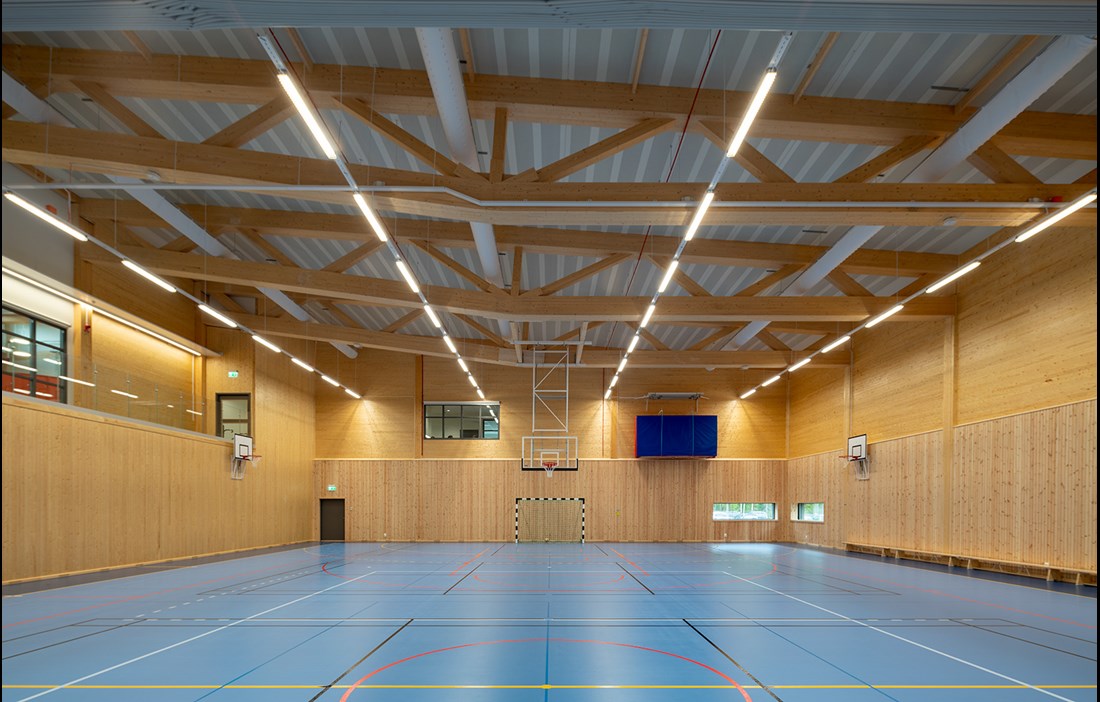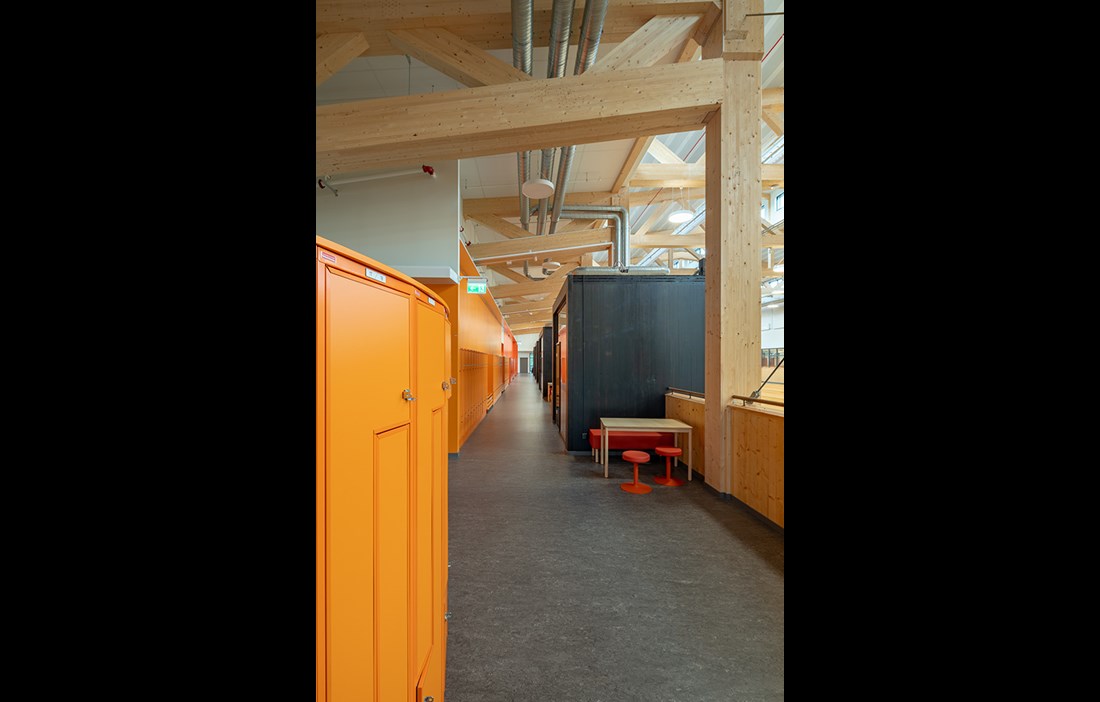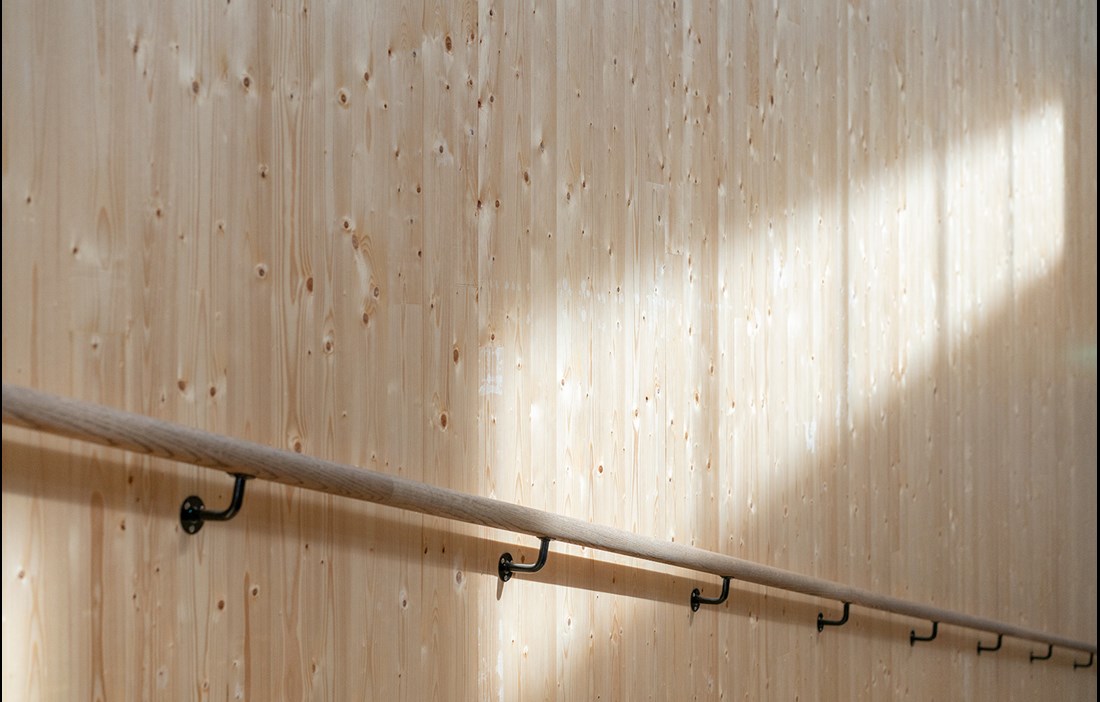Morö Backeskolan’s relatively modest façade in grey-brown glulam cladding gives very few clues about what awaits inside. While the exterior of the new high school section is designed to blend into the surroundings and form a single unit with the elementary and middle school section from the 1970s, the interior architecture makes a very distinctive statement. Most striking is the 16 metre high and 900 square metre atrium, which serves as both a formal and an informal meeting place, with tiered benches in hard wax oiled glulam where people can sit and chat or listen to a speaker on the stage below. The open area at the bottom has a student café with an eye-catching triangular bar counter made from CLT.
The atrium is more than just an assembly point for everyone in the school – it is also the hub around which all the rooms and functions of the high school are gathered. This makes it easy for people to orientate themselves, wherever they are in the school. Functions such as classrooms, break out rooms, workshops, a dining hall and a sports hall all run off the atrium.
“The planning work with the teachers focused on safety and openness as the most important factors to build on, a tricky puzzle as so many of the functions had to be centrally located, avoiding enclosed corridors. The atrium offered a layout that met the requirements while also allowing for efficient construction with a low form factor,” says Mats Jakobsson, chief architect at Maf Arkitektkontor, who designed the new school on behalf of developer Peab.
Apart from the glazing, all the surfaces in the airy atrium are a combination of glulam and CLT. The glulam roof structure has been left exposed, contributing to the warm, vibrant feel.
“This glulam roof design is unique and we’re the only ones in Sweden to do it. It’s rare to see glulam exposed like this in a school, and as a glulam supplier, I’m over the moon to see the finished result,” says Göran Wahlberg, sales engineer at Martinsons, which supplied all the engineered wood for the project.
Another standout feature coming off the atrium is the cubic, partially cantilevered break out rooms, which float a few metres above the ground. Aside from the windows that look out onto the atrium, the cubes are all CLT.
“In total, we delivered close to 1,100 cubic metres of glulam and CLT for this project, so there is definitely a lot of wood in the building,” says Göran Wahlberg.
It is not by chance that the majority of the school’s new section is made of wood. According to Skellefteå Municipality’s wood construction strategy, wood is to be considered as the first choice in all building and infrastructure projects run by the municipality. The strategy also says that wood or other renewable materials must always be chosen where technically and financially viable. This is why most parts of Morö Backeskolan are made of wood, with certain load-bearing elements in concrete and steel where necessary.
“It has ended up as an extremely good combination, where we’ve chosen wood as much as we can, but brought in some other materials due to sound, moisture, fire safety and cost considerations. In our experience, however, it’s possible to keep costs down if you include wood as an option right from the start. Here the wood in the structural frame, for example, has also become part of the interior design,” says Emma Sundelin, project manager at Skellefteå Municipality.
The actual construction project began just over two years ago and was split into two parts. One involved freshening up the old elementary and middle school buildings, both of which were getting overcrowded and tired; the other involved building a brand new high school building.
“We’re working on a restructuring of schools in Skellefteå Municipality and this part of the town was in need of an additional high school. The decision was made to build the new school on the same site as the existing elementary and middle school, and to give it a full-sized sports hall that could also be used for other activities in the evening and at weekends. The plan also included adapting the existing school to make it all feel like a single entity. We’ve now built a new kitchen for everyone in the new part of the school, for example,” says Emma Sundelin.
She is clear about the many advantages of building in wood.
“First and foremost, there’s the environmental aspect. We know that wood has less of an impact on our environment than other materials, particularly in terms of carbon emissions. We also know that people feel better when they’re surrounded by wood. By using wood for the frame and part of the interior design, we’re killing two birds with one stone. In addition, the working environment during the actual construction period is much more pleasant, with less dampness and a better sound environment than when working with other materials,” she points out.
The project has been set up as a partnering project with Skellefteå Municipality as the client, Peab as the main contractor, Maf Arkitektkontor as the architect and Martinsons as the supplier of all the engineered wood – which has proven a dream combination.
“Honestly, this is the best partnering arrangement I’ve ever been part of. I’d put the success down to the superb personal chemistry between everyone involved and the fact that we established a good working method. Instead of large planning meetings, we had regular weekly meetings that included visual planning, and this constantly drove the work forward,” says Mats Jakobsson.
Thanks to this close cooperation, they also managed to cut the planned construction time from two and a half to two years.
“Because we had students using the school throughout the build, it was essential for us to keep the disruption to a bare minimum. However, we did come to an agreement that it was better to accept a little more disruption for a short period in order to reduce the construction time,” says Emma Sundelin.
The excellent level of collaboration also helped when it came to dealing with another challenge – keeping to the project’s budget, when the costs suddenly looked like they might spiral out of control due to the school’s desire to get as many rooms as possible out of the design.
“To bring it in on budget, we needed to cut costs by SEK 40 million. However, we worked together to reduce the floorplan in a good way that would keep the teachers and the other users of the school happy,” says Mats Jakobsson.
In the atrium and sports hall, both the frame and the surface layer are wood all the way down to the floor. In the classrooms and dining halls, on the other hand, a steel frame supports a first floor with a hollow-core concrete deck. Steel posts were the easiest way to meet the requirement for the frame to be concealed in the walls in these sections. Above that is a glulam frame, with roof trusses coming off most of the uprights. Combining the glulam frame with CLT has also made it possible to create an extra strong structure that can handle the large spans – 26 metres at the widest point.
Perhaps the biggest technical challenge of the project was designing the large eaves to cope with heavy snow loads.
“This requires a flexible transition between wall and roof. The greatest difficulty lies in achieving a working solution that also offers good sound insulation. The answer is a telescopic joint on the walls, which means the roof can drop down five centimetres with no problem,” says Mats Jakobsson.
Part of the interior’s intricate roof design continues outside to form part of the main entrance canopy. Elsewhere, the school’s façade is finished in 30 centimetre wide painted glulam cladding, with slightly narrower dimensions used around the curved sections by the entrances.
“On the gables, we’ve used regular solid posts and beams in glulam instead of glulam trusses. The roof is also made of wood, using lightweight components from a company in Örnsköldsvik that manufactures units with hardboard beams, which they insulate and make into a finished roof,” says Robert Andersson, project manager at Martinsons.
The unique interior design at the school has attracted a great deal of attention from across Sweden and prompted numerous study visits even before the school opened for this year’s autumn term. Housing Minister Peter Eriksson was just one of the dignitaries who was keen to take a look.
“We’ve really ended up with a fantastic school. It’s good from an operational and an investment point of view, it’s energy efficient and it makes incredibly effective use of space, despite us having such large open areas. I’m pleased that we’ve been able to design out all the corridors that can be so dull and unsafe. Plus we have a school that’s made almost entirely from wood,” says Emma Sundelin.
Text Sara Bergqvist

